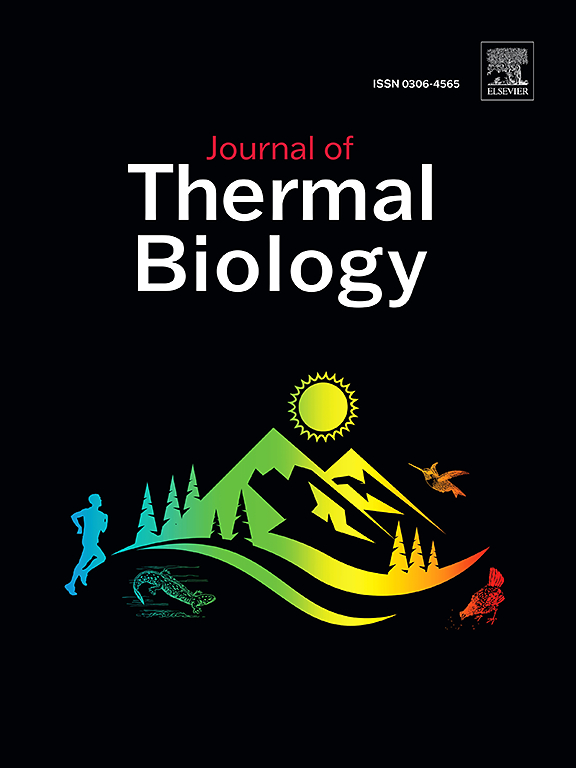热液生理学和对气候变化的脆弱性:来自欧洲毒蛇的见解
IF 2.9
2区 生物学
Q2 BIOLOGY
引用次数: 0
摘要
澄清生理适应对于了解物种分布和预测对气候条件变化的脆弱性至关重要。同时考虑能源和水的限制是必要的,因为这些方面在变温动物中是相互交织的。蝰蛇属是古北蛇的一个多样化的群体,具有异域分布和对比的气候亲缘关系。这些物种是活跃的温度调节器,依靠晒太阳来维持体温。虽然一些物种如V. berus和V. seoanei适应寒冷和潮湿的环境,但其他物种具有中间(温带-海洋)亲缘关系(V. aspis),而一些物种如V. latastei和V. ammodytes生活在温暖和半干旱气候中。为了更好地了解物种对气候变化的脆弱性,我们研究了这五个物种与能量和水分平衡相关的生理性状。首先,我们使用开放流量呼吸法量化了三种温度(15°C、25°C和33°C)下的标准代谢率(SMR)和蒸发失水(TEWL)。冷适应和湿适应物种表现出更高的代谢率和蒸发水分损失率,反映了对寒冷、潮湿环境的适应,而暖适应和干适应物种表现出更低的代谢率。其次,我们使用这些数据来研究它们对极端气候事件(ECE)的生理反应。对夏季高温天气的模拟反应显示,不同物种的能量消耗和水分损失率显著增加。然而,这种效应在适应冷、湿环境的物种中更为显著。这项研究强调了适应寒冷和潮湿的物种在极端气候事件中面临的生理限制,为了解变温动物对持续环境变化的脆弱性提供了见解。本文章由计算机程序翻译,如有差异,请以英文原文为准。

Hydrothermal physiology and vulnerability to climatic change: insight from European vipers
Clarifying physiological adaptations is crucial to understand species distribution and predict vulnerability to changing climatic conditions. Considering energy and water constraints jointly is necessary because these facets are intertwined in ectotherms. The genus Vipera is a diversified group of Palearctic snakes with parapatric distributions and contrasted climatic affinities. These species are active thermoregulators relying on basking to maintain their body temperature. While some species such as V. berus and V. seoanei are adapted to cold and wet environments, other species have intermediate (temperate-oceanic) affinities (V. aspis), and some such as V. latastei and V. ammodytes inhabit warm and semi-arid climates. We studied physiological traits related to energy and water balance in these five species to better understand species' vulnerability to climate change. First, using open-flow respirometry we quantified standard metabolic rate (SMR) and evaporative water loss (TEWL) at three temperatures (15 °C, 25 °C and 33 °C). Cold- and wet-adapted species exhibited higher metabolic rates and evaporative water loss, reflecting adaptations to colder, wetter environments, while warm- and dry-adapted species showed lower rates. Second, we used these data to investigate their physiological responses to extreme climatic events (ECE). Simulated responses to summer heat spells revealed a major increase in energy expenditure and water loss rates across species. However, the effect was more prominent in cold- and wet-adapted species. This study underscores the physiological constraints that cold and wet-adapted species face during extreme climate events, providing insights into the vulnerabilities of ectotherms to ongoing environmental changes.
求助全文
通过发布文献求助,成功后即可免费获取论文全文。
去求助
来源期刊

Journal of thermal biology
生物-动物学
CiteScore
5.30
自引率
7.40%
发文量
196
审稿时长
14.5 weeks
期刊介绍:
The Journal of Thermal Biology publishes articles that advance our knowledge on the ways and mechanisms through which temperature affects man and animals. This includes studies of their responses to these effects and on the ecological consequences. Directly relevant to this theme are:
• The mechanisms of thermal limitation, heat and cold injury, and the resistance of organisms to extremes of temperature
• The mechanisms involved in acclimation, acclimatization and evolutionary adaptation to temperature
• Mechanisms underlying the patterns of hibernation, torpor, dormancy, aestivation and diapause
• Effects of temperature on reproduction and development, growth, ageing and life-span
• Studies on modelling heat transfer between organisms and their environment
• The contributions of temperature to effects of climate change on animal species and man
• Studies of conservation biology and physiology related to temperature
• Behavioural and physiological regulation of body temperature including its pathophysiology and fever
• Medical applications of hypo- and hyperthermia
Article types:
• Original articles
• Review articles
 求助内容:
求助内容: 应助结果提醒方式:
应助结果提醒方式:


